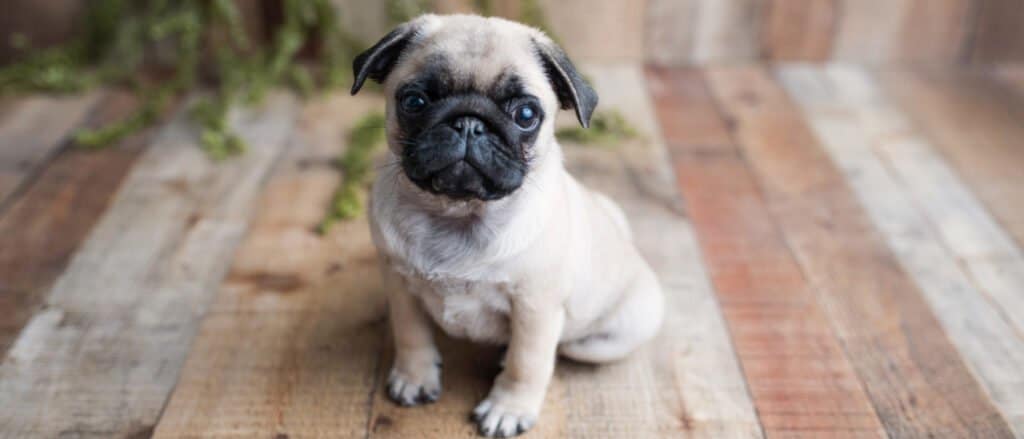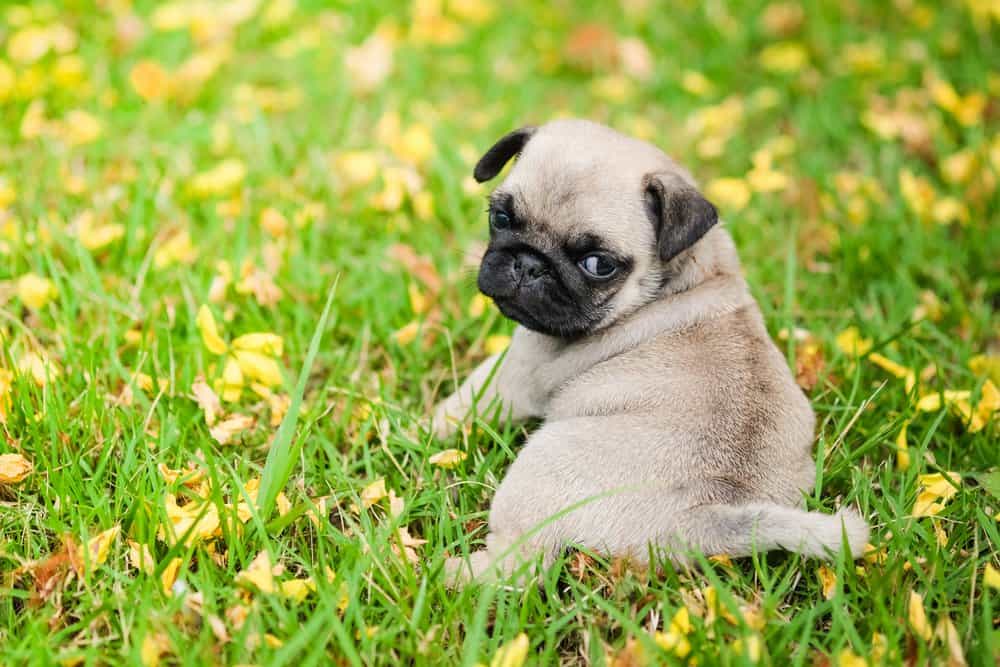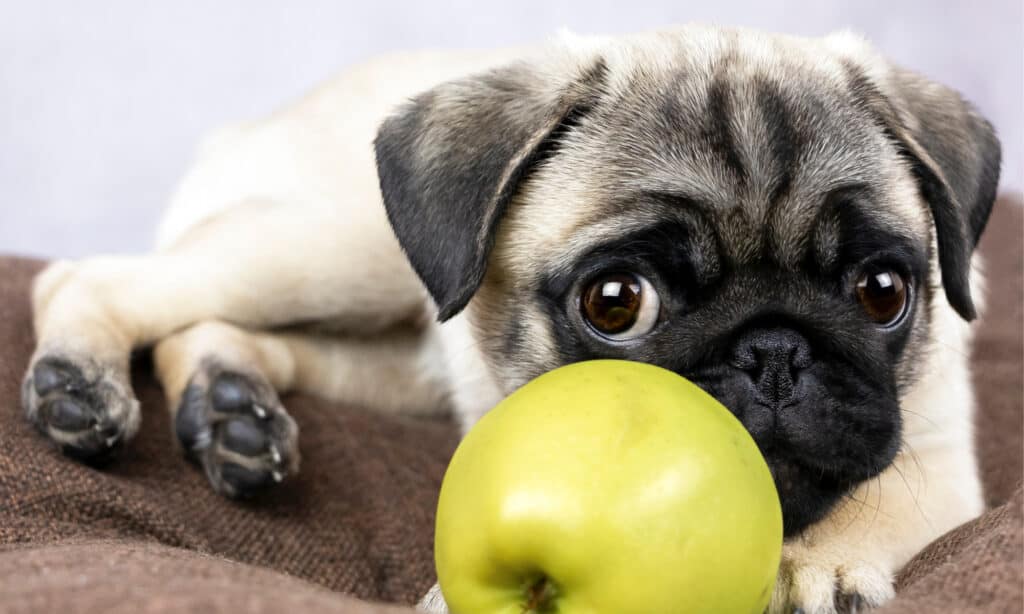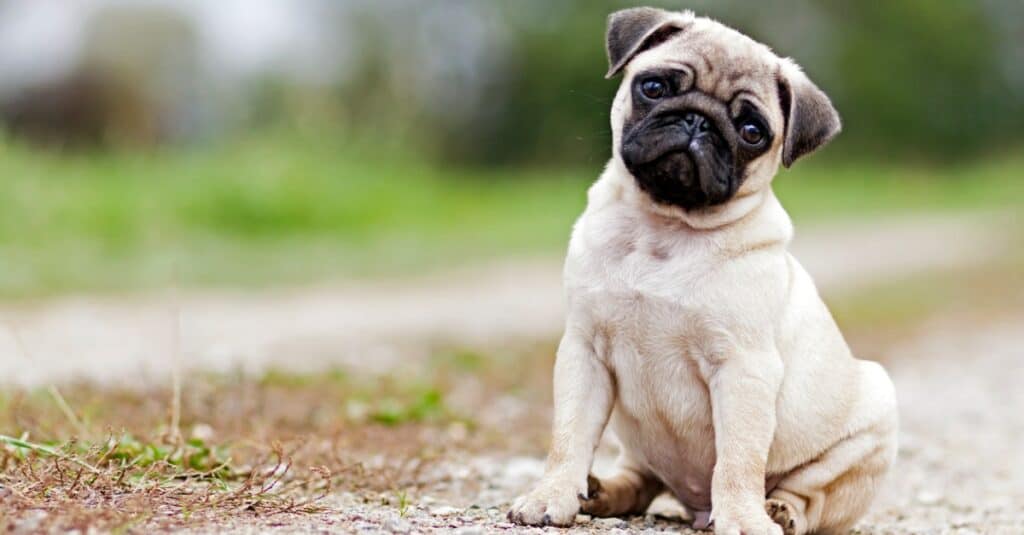The pug is among the most popular and recognizable small dog breeds, but it’s worth noting that it isn’t ideal for everyone. If you’re interested in bringing home a pug puppy, read on. We’ll review the breed’s history, fun facts, how pug puppies look and behave at various life stages, growth milestones to expect, and tips for adoption below! We’ll also cover how to find a reputable breeder or adoption center.
The Pug: History of the Breed and Fun Facts

The pug is an ancient Chinese breed popularized in Europe in the 1500s.
©Ezzolo/Shutterstock.com
Unbeknownst to many dog lovers, the pug is originally an ancient Chinese dog breed with roots dating back to 400 BC! They were first bred as companions to Chinese royalty before eventually being exported to Europe in the 1500s. They quickly became quite popular in Western Europe, with Queen Victoria taking a particular interest in the breed in the 1800s.
Ancient Chinese royals were no stranger to breeding flat-faced (or brachycephalic) dog breeds. Around the time they were developing the pug’s ancestor, the Lo-sze, they were also breeding the Pekingese, then known simply as the “lion dog.” Even Tibetan monks enjoyed the company of pugs, with the dogs’ charming, people-pleasing nature being prized among them, as well as Chinese royalty.
The pug breed remains extremely popular today, particularly amongst other small companion breeds. The origins of its name today are widely debated, with some historians claiming it originated from the marmoset, also known as the “pug monkey.” Alternatively, it may have come from the Latin word “pugnus,” meaning “fist,” which could refer to the breed’s heavily wrinkled forehead.
What Do Pug Puppies Look Like?

Like their mature adult counterparts, pug puppies have large, round eyes, a distinctively brachycephalic face, and a short, upturned snout with small nostrils.
©TanyaCPhotography/Shutterstock.com
The puppy version of the pug more or less resembles a smaller version of its fully mature adult form. Its most prominent trait is its brachycephalic, flat face, large, wide-set round eyes, underbite, and upturned, broad, rounded snout. The body is often defined as “cobby” by dog breeders and enthusiasts. This means it has a short and square-like build.
The pug’s legs are short, stout, and rather well-muscled for its size. It has a broad, deep chest for a small breed. Another distinctive trait is the curled tail. This typically gains its irregular shape once a pug puppy ages two to three weeks.
The ears of a pug can have two shapes: rose and button. The button is generally the breed standard and more common than the rose shape. Rose ears are slightly smaller than the button shape. They are folded with the front edges lying against the sides of the dog’s head.
The coat of a pug puppy can vary, though it comes in four primary colors. These are black, fawn, apricot fawn, and silver fawn. Markings around the face are darker than the overall body color, usually dark brown to black. A dark brown to black line extends down the back to the tail. The paws are tiny with comparatively wide ankles, and the nails are dark brown to black.
How Much Do Pug Puppies Cost?

Pug puppies can cost anywhere from $350 to over $2,000. This depends on whether you purchase them from a breeder or adopt them from a shelter or rescue.
©Ezzolo/Shutterstock.com
If you plan on buying a pug puppy from a breeder, you can expect to shell out anywhere from $800 to over $2,000. This can vary depending on your location, the age, color, and overall appearance of the dog, and the breeder. This can vary significantly, but at least $800 is the lower end of the spectrum. If it is any lower than this, you risk buying a mixed breed or improperly bred dog from an untrustworthy breeder.
Alternatively, if you plan on adopting a pug from a shelter or rescue, you can expect a much lower price in the range of around $300 to $600. However, puppies can be hard to come by at shelters and rescues, meaning you may be waiting months or even years to find your ideal dog.
Remember, this does not include the cost of supplies, food, veterinary bills, and other general day-to-day maintenance costs. This only covers the price of the puppy itself.
How to Find a Reputable Pug Puppy Breeder

Finding a reputable breeder is essential to finding and bringing the perfect pug pup home.
©iStock.com/Irina Stolyarova
Finding a reputable pug puppy breeder is essential to ensure you buy a healthy, happy dog without behavioral or other health issues. A great place to start is by simply asking your veterinarian if you have already selected one. If you haven’t decided on a vet in your area yet, feel free to call around local vet offices and ask about reputable breeders in the area, as well as shelters and rescues.
Additionally, looking around online can help you find a breeder or rescue for your prospective pup. For instance, online clubs like the Pug Dog Club of America often have extensive breeder directories for various locations. The breeders listed here are in good standing with the PDCA and have completed at least one AKC title on their pugs.
If you’re in the UK, there’s also the Pug Breed Council. This group similarly has a guide for finding a puppy to purchase or adopt, as well as information on how to avoid puppy farms and dishonest breeding tactics.
If you’re considering adopting a pug instead of purchasing from a breeder, you’ll be happy to know many pug rescues exist in the United States and worldwide. These include the Bluegrass Pug Rescue, the Mid-Atlantic Pug Rescue, and the Tiny Paws Pug Rescue. They are excellent sources to find pugs of all ages and backgrounds, often at a much lower cost than purchasing a puppy from a breeder.
Finally, if you know a friend or family member with a pug they are happy with, you can always ask them where they purchased or adopted the dog. Furthermore, online pug owner forums are another excellent place to search for adoptable pugs and reputable breeders, as these people often have extensive experience buying and adopting dogs.
How Big Are Pug Puppies?

Once your prospective pug puppy is at least two months old, you can bring them home!
©iStock.com/LexiTheMonster
When they are first born, pug puppies weigh less than a pound. They increase, however, and are puppies until they are around 9 to 12 months old. They generally gain around one to two pounds per month until they reach their full size. This is usually somewhere between 13 and 18 pounds.
Remember, puppies must stay with their mothers until they are roughly eight weeks old. You won’t be able to purchase, adopt, or otherwise bring your puppy home until they are at least two months old. At this point, a pug puppy is roughly two to four pounds. Below, we’ll go into more detail about growth milestones month by month. We’ll also provide an at-a-glance chart of these growth milestones.
Pug Puppy Growth Milestones and Growth Chart
As mentioned earlier, pugs start their lives at less than a pound. They will quickly put on anywhere from one to three pounds per month as they age. This growth pattern will continue until the first year or so of their lives. You can begin housetraining your puppy as soon as you bring them home. However, keep in mind you may not notice much progress until the four-month mark or so. Be sure to have plenty of puppy pee pads on hand until (and likely for a while after) that point.
Your pug puppy likely started eating solid food by around the one-month mark. You can continue feeding them puppy food until they are nine months old. Ensure the bowl you use for their food is low, shallow, and easily accessible, as puppies eat–a lot!
You can begin engaging in gentle play with your puppy soon after bringing them home. Once they’ve become acclimated to their surroundings, you can introduce toys ideal for puppies and even begin taking them on walks outside to socialize them better. As your puppy becomes more independent, they may be fearful of their surroundings at first. This, fortunately, is normal as they learn what is safe and unsafe, comfortable and uncomfortable, etc., for them.
By the 12-week mark, you’ll want to ensure you have plenty of chew toys for your pup to accommodate their growing teeth. You can also begin crate training around this time and get them more used to becoming housetrained.
Once your dog reaches six months, or roughly 22 to 24 weeks old, they are officially in the adolescent or “teenage” stage. “At this “time, your pup should be between 7 and 12 pounds. They may be finished with housetraining, or you may still be working on establishing this milestone. Continue socialization and encourage safe play as your dog learns more about their surroundings and what to expect from you and your home.
Pug Puppy Growth Chart: Age and Weight
| Age | Approximate Weight |
| Two months | 1-2 pounds |
| Three months | 2-4 pounds |
| Four months | 4-7 pounds |
| Five months | 5-9 pounds |
| Six months | 7-10 pounds |
| Seven months | 7-12 pounds |
| Eight months | 9-12 pounds |
| 8 months | 11-14 pounds |
| 9 to 12 months | 13-18 pounds |
The photo featured at the top of this post is © TanyaCPhotography/Shutterstock.com
Ready to discover the top 10 cutest dog breeds in the entire world?
How about the fastest dogs, the largest dogs and those that are -- quite frankly -- just the kindest dogs on the planet? Each day, AZ Animals sends out lists just like this to our thousands of email subscribers. And the best part? It's FREE. Join today by entering your email below.
Thank you for reading! Have some feedback for us? Contact the AZ Animals editorial team.






